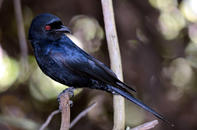
Name
Fork-tailed Drongo - Dicrurus adsimilis
Appearance
The fork-tailed drongo is a medium sized bird at 25 cm in length, including the tail. The fork-tailed drongo has a mainly glossy black plumage, with the wings being a little duller. This bird has a large head with a hooked black bill and a red eye. The tail is deeply forked.
The fork-tailed drongo can be easily mistaken for a southern black flycatcher (melaenornis pammelaina) as the two birds are very similar in appearance, except the drongo has a red eye and the flycatcher has a brown eye.
Fork-tailed Drongo Diet
The fork-tailed drongo feeds almost exclusively on insects, with the main food being bees hawked on the wing. Tick and parasites are taken from larger mammals. This drongo has also been recorded eating small birds and nectar. The fork-tailed drongo is a kleptoparasite specialist.
Fork-tailed Drongo Breeding
The fork-tailed drongo is monogamous. The nest is a poorly made wide shallow cup that is either suspended between two branches, like a hammock, or placed high up in a tree, in a fork. Two to four eggs are laid. Drongos are regular brood hosts for the African cuckoo.
Fork-tailed Drongo Behaviour
The fork-tailed drongo will hunt from a perch, hawking insects. They are normally solitary, but may be seen in pairs during the breeding season. The fork-tailed drongo is an aggressive and fearless bird, often mobbing larger species of birds if they feel threatened. They are often seen mobbing or harassing birds of prey. This drongo will follow larger mammals to feed on any insects that are disturbed when the mammal moves.
The fork-tailed drongo can mimic the alarm call of some mammals and birds, like meercats and some of the babblers. The drongo will alarm call and cause the animal to flee and or hide from the danger or predator that is not there, the drongo then flies in and steals the food of the unsuspecting animal.
This practice is a form of kleptoparasitism. The drongo will also mimic the alarm call of some of the bigger mammals, causing the mammals to move around, which flushes insects up from the ground making it easier for the drongo to hunt.
Mobbing
Birds of prey are often mobbed by the cocky fork-tailed drongo. This is a tactic used to encourage the raptor to leave the vicinity. The drongo recognizes the raptor as a predatory threat but it is aware that the raptor relies on the element of surprise to attack prey.
Being smaller and more manoeuvrable, the drongo is able to dive-bomb perched raptors, or even sometimes those in flight, pecking them annoyingly behind the head, without fear of being caught by the larger bird, which has neither surprise nor speed-from-rest to its advantage.
By Megan Emmet
Threats
None.
Distribution and Habitat
The fork-tailed drongo has a wide distribution across South Africa, and can be found in most woodlands and forests and is a common visitor to urban gardens.